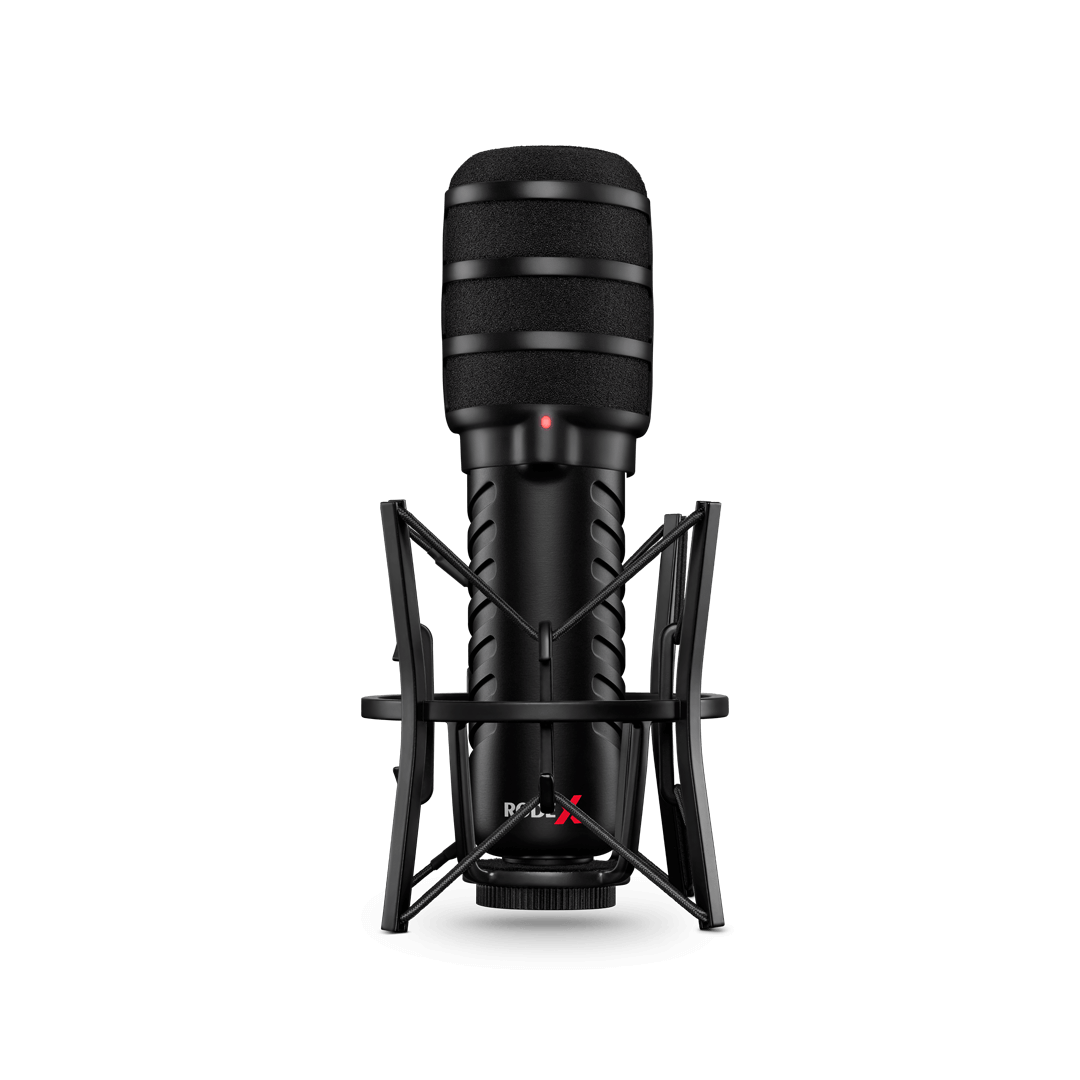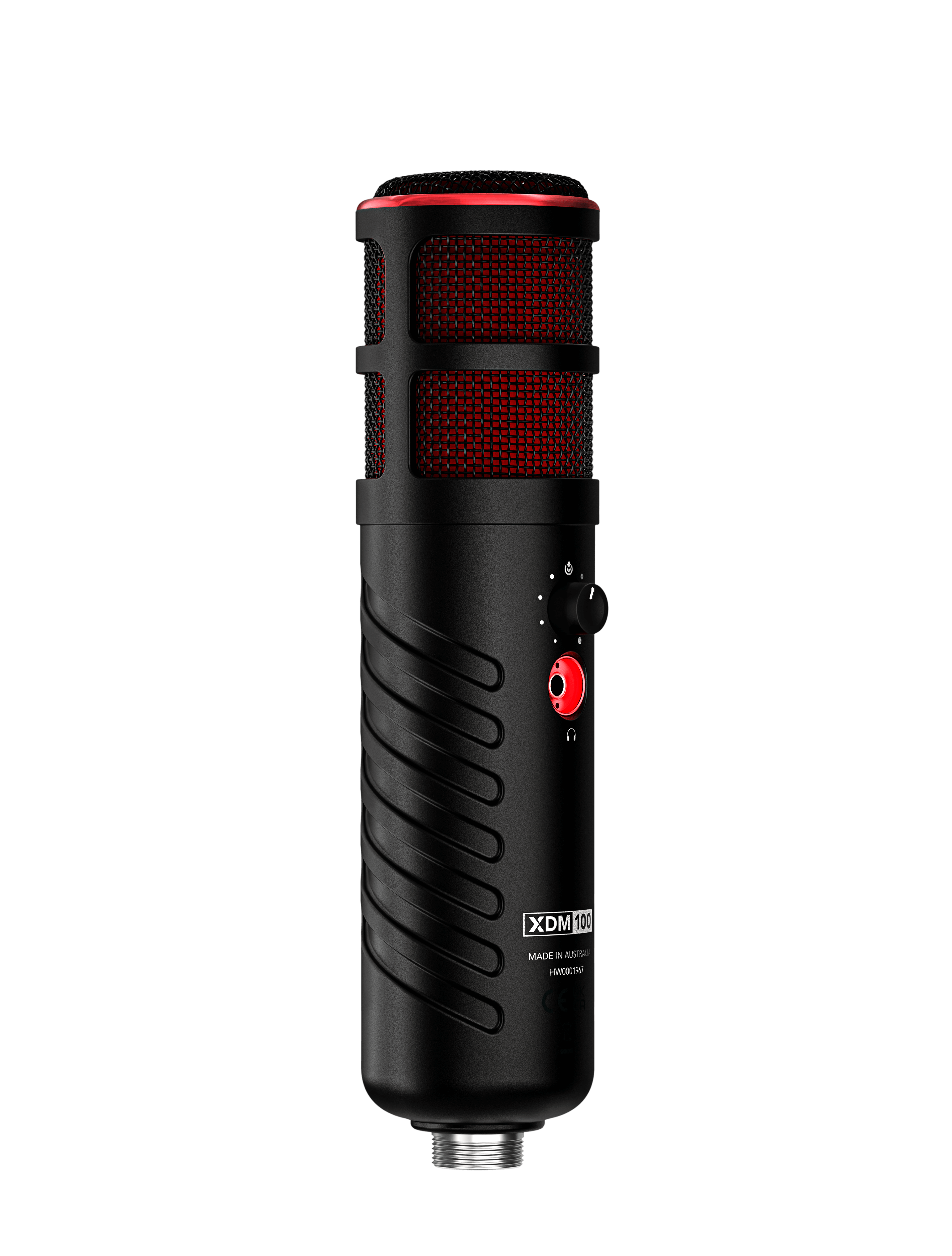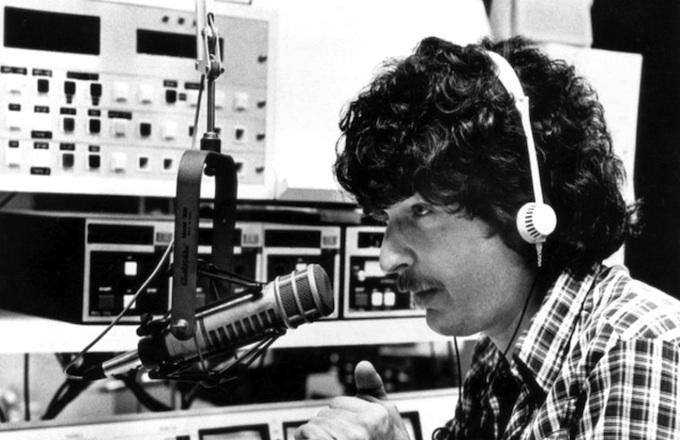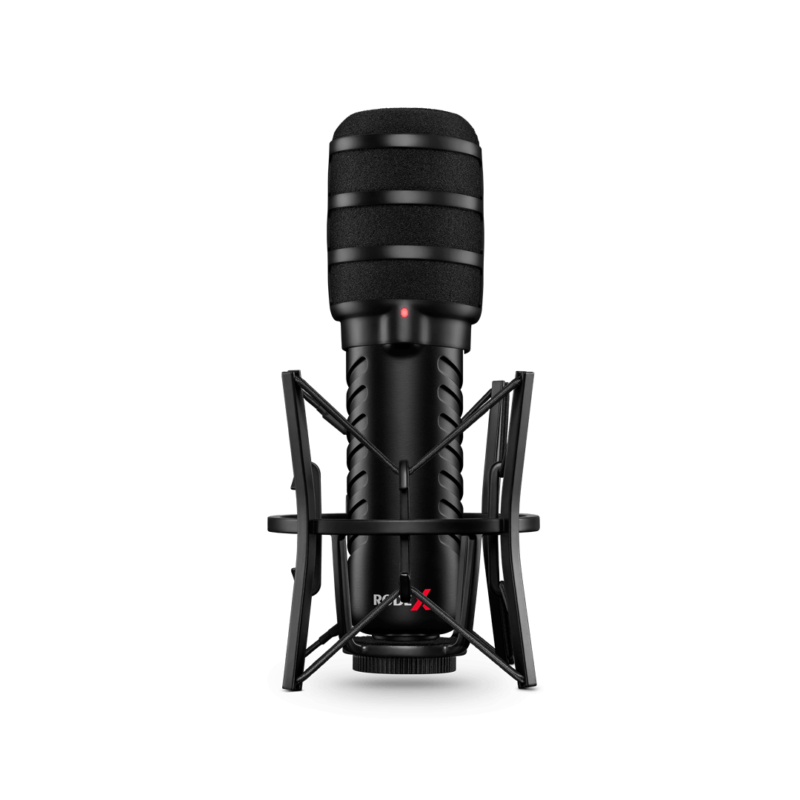Here is my review of the new U$249 RØDE XDM-100 studio dynamic USB microphone. It’s RØDE’s first dynamic microphone with an internal DSP (digital signal processor), which makes it historic. Although the XDM-100 indeed works with macOS and Windows, as of publication date of this review, the XDN-100 internal digital signal processor’s features are only accessible via RØDE’s UNIFY software, which is now free for everyone, although it’s currently available only for Windows 10 or 11. Ahead you’ll find written information and audio recordings done with and without the DSP’s features active, as well as a blind test with another dynamic studio microphone I reviewed recently. There will even be a brief fictional conversation about microphones with shock jock Howard Stern.

Above, XDM-100 with shockmount and windscreen. (Image courtesy of RØDE)
Scope of this XDM-100 mic review
This review is primarily about the XDM-100 microphone (and its included accessories) and mentions about the PSA1+ flexible boom arm (not included) and NTH-100 isolating headphones (reviewed here, not included). This is not a review of the UNIFY software, which I plan to cover completely in the future. In this XDM-100 mic review, I use the UNIFY software in order to access certain features in the DSP so you can hear how the microphone sounds with and without those features. The UNIFY software is now transitioning from being a paid product (for users of microphones which are not from RØDE) to a free product for all (but now works exclusively with certain RØDE microphones). It is best to let the dust settle before reviewing the UNIFY software fully.

Above, XDM-100 without shockmount or windscreen. (Image courtesy of RØDE)
RØDE’s pitch on the XDM-100
The XDM-100 is a professional dynamic USB microphone that (per RØDE) delivers rich, broadcast audio ideal for live streaming and gaming. It features RØDE’s ultra-low-noise, high-gain Revolution Preamp and high-resolution 24-bit/48 kHz analog-digital conversion ensuring pristine audio quality. It comes with a high-quality pop shield and shock mount for mitigating unwanted plosives (pops), knocks and bumps. A high-power headphone output provides flawless zero-latency audio monitoring and playback, with hands-on level control and microphone mute functionality.
The XDM-100 also features a powerful internal digital signal processing (DSP), which can be unlocked using the UNIFY software. This allows users to add advanced APHEX audio processing to their voice – including a compressor, noise gate, high-pass filter (aka low cut filter), and the legendary Aural Exciter and Big Bottom effects – with full granular control over every parameter for crafting their own signature sound. Together, UNIFY and a RØDE X microphone offer a complete audio solution for streaming or gaming with the full capabilities of a professional broadcast studio.
It is possible that in the future, the XDM-100’s DSP may be accessible from other software like RØDE Connect or RØDE Central. If that ever happens, I’ll cover that in a future article.
Importance of the DSP in a microphone
The internal DSP (digital signal processor) in a microphone (or audio interface) is valuable since it can alleviate processing in a host computer, even though (in this case), the computer and a piece of software is required to activate or adjust the DSP. It takes the computer a tiny bit of resources to do that, as opposed to having the computer actually perform the effects in real time.
The XDM-100 size

After reading my recent article StreamYard-a great experience, with happy surprises (illustrated above, where I was using the XDM-100 and a nearly invisible IFB instead of the NTH-100 headphones), a very good friend (Jeff Taylor of Beaker Films) wrote to me: “Your microphone looks good, but very big!”
Jeff Taylor is quite correct. That’s why —when I first covered the XDM-100 after RØDE’s announcement a couple of months ago, I created this size comparison chart:
| Length
(millimeters, rounded) |
Weight
(grams, rounded) |
|
| Electro-Voice RE20 | 216 | 737 |
| Electro-Voice RE320 | 216 | 681 |
| FDUCE SL40 | 151 | 463 |
| RØDE Broadcaster | 167 | 577 |
| RØDE Procaster | 214 | 745 |
| RØDE PodMic | 172 | 937 |
| RØDE X XCM-50
(although not broadcast-style in appearance) |
119 | 492 |
| RØDE X XDM-100 | 213 | 700 |
| Shure MV7 | 153 | 550 |
| Shure SM7B | 190 | 767 |
At 213 mm long, the new RØDE XDM-100 is closest in length to the RØDE Procaster, Electro-Voice RE20 and RE320. These four mics are the longest of the listed mics. Given the size similarity with the RE20, I had a flashback to the 1980s, when shock jock Howard Stern was at WNBC in New York and used the RE20 from Electro Voice, a classic microphone which even RØDE honored with its own preset in the RØDECaster Pro.

Above, Howard Stern in the 1980s using the RE20 and its external shockmount. He was at WNBC in New York. (Image courtesy of Facebook WNBC tribute.) That’s why, I responded to my friend who had made that comment about the XDM-100’s size:
If Howard Stern of the 1980s could have commented about my interview appearance covered in StreamYard-a great experience, with happy surprises, Howard Stern would likely taunt me by saying:
Allan, my microphone is 3 mm longer than yours!

Image, courtesy of SiriusXm.
However, today Howard Stern apparently uses a U$729 Neumann BCM 705 at SiriusXm (which measures 85 mm in length), so I suppose that the present-day Howard Stern would say:
Allan, my microphone is 34 mm shorter than yours!
Of course, my comment back to him would be:
Howard, your Neumann BCM 705 sounds great, but you are getting plosives way too often. You should know the trick about putting the magnetic Aston Pop Filter (made for the Aston Element microphone) onto the Neumann BCM 705. It just snaps on, really solves the plosives and looks like it were made for the BCM 705. It costs only U$29 but is really hard to find.
XDM-100 specs
- Polar Pattern: Cardioid
- Capsule: Dynamic
- Frequency Range: 20 Hz — 20 kHz
- Connectivity: USB-C
- Analog Outputs: 3.5mm Headphone Output
- Sample Rate: 48kHz
- Bit Depth: 24-bit
- OS Requirements: MacOS 10.12, Windows 10
- Net weight: 700g
- Dimensions: 52 mm x 213 mm
- Included accessories: PSM1 Shock Mount, SC29 USB-C to USB-C cable, 3m headphone extension cable, pop shield
Blind test recording with the FDUCE SL40
Below are blind test recordings against the FDUCE SL40 (reviewed here). No DSP effects were active in the XDM-100 during this blind test recording. However, there will be DSP effects revealed in the upcoming section.
Audio PlayerAbove, microphone 1.
Audio Player
Above, microphone 2.
Actual recordings of the XDM-100
Audio PlayerIn the above recording, I go through each preset of the DSP, including two positions of the high-pass filter (aka low cut filter): 75 Hz and 150 Hz, the soft noise gate, compressor, Aural Exciter, Big Bottom. There are indeed granular adjustments available for all of these effects. However, for brevity, I used the preset amount for each one.
Latency free monitoring
The latency free monitoring works great and has plenty of power. It also works for hearing playback the host app (UNIFY) to hear other participants, cart (sound board) playback. The microphone is automatically muted when playing back a recorded take in UNIFY. When connected to a Mac (without UNIFY), the latency free monitoring also works very well.
Muting options
You can mute and unmute using the built-in button on the XDM-100. However, there is a noticeable click, as you probably heard in the test recording above. You can also mute and unmute a particular mic source using the icon within the UNIFY software, which is much quieter by comparison. No muting option is available currently when connected to a Mac computer.
Ratings
Build quality and appearance

Sound quality without DSP effects

(On Windows or macOS)
Sound quality with DSP effects

(although currently available only with UNIFY on Windows)
Latency-free monitoring

(although currently available only with UNIFY on Windows)
Mechanical mute button functionality

Software mute functionality

(although currently available only with UNIFY on Windows)
Shockmount performance

Key to blind test
In the blind test, microphone 1 was the FDUCE SL40 and microphone 2 was the XDM-100.
Pricing and availability
The XDM-100 is available for U$249 including the external shockmount and external windscreen.
Conclusions
I applaud RØDE for creating its first dynamic microphone with a built-in DSP, the XDM-100. This is truly historic. I also love the sound quality and flexibility, although to take full advantage of the XDM-100, Windows is currently required. Hopefully, some software for macOS will be able to access the DSP too.
(Re-)Subscribe for upcoming articles, reviews, radio shows, books and seminars/webinars
Stand by for upcoming articles, reviews, books and courses by subscribing to my bulletins.
In English:
- Email bulletins, bulletins.AllanTepper.com
- In Telegram, t.me/TecnoTurBulletins
- Twitter (bilingual), AllanLTepper
En castellano:
- Boletines por correo electrónico, boletines.AllanTepper.com
- En Telegram, t.me/boletinesdeAllan
- Twitter (bilingüe), AllanLTepper
Most of my current books are at books.AllanTepper.com, and also visit AllanTepper.com and radio.AllanTepper.com.
FTC disclosure
RØDE is not paying for this review. Some manufacturers listed above have sent Allan Tépper review units, including RØDE and FDUCE, but not yet from Aston or Neumann. Some of the manufacturers listed above have contracted Tépper and/or TecnoTur LLC to carry out consulting and/or translations/localizations/transcreations. So far, none of the manufacturers listed above is/are sponsors of the TecnoTur, BeyondPodcasting, CapicúaFM or TuSaludSecreta programs, although they are welcome to do so, and some are, may be (or may have been) sponsors of ProVideo Coalition magazine. Some links to third parties listed in this article and/or on this web page may indirectly benefit TecnoTur LLC via affiliate programs. Allan Tépper’s opinions are his own. Allan Tépper is not liable for misuse or misunderstanding of information he shares.

Filmtools
Filmmakers go-to destination for pre-production, production & post production equipment!
Shop Now












